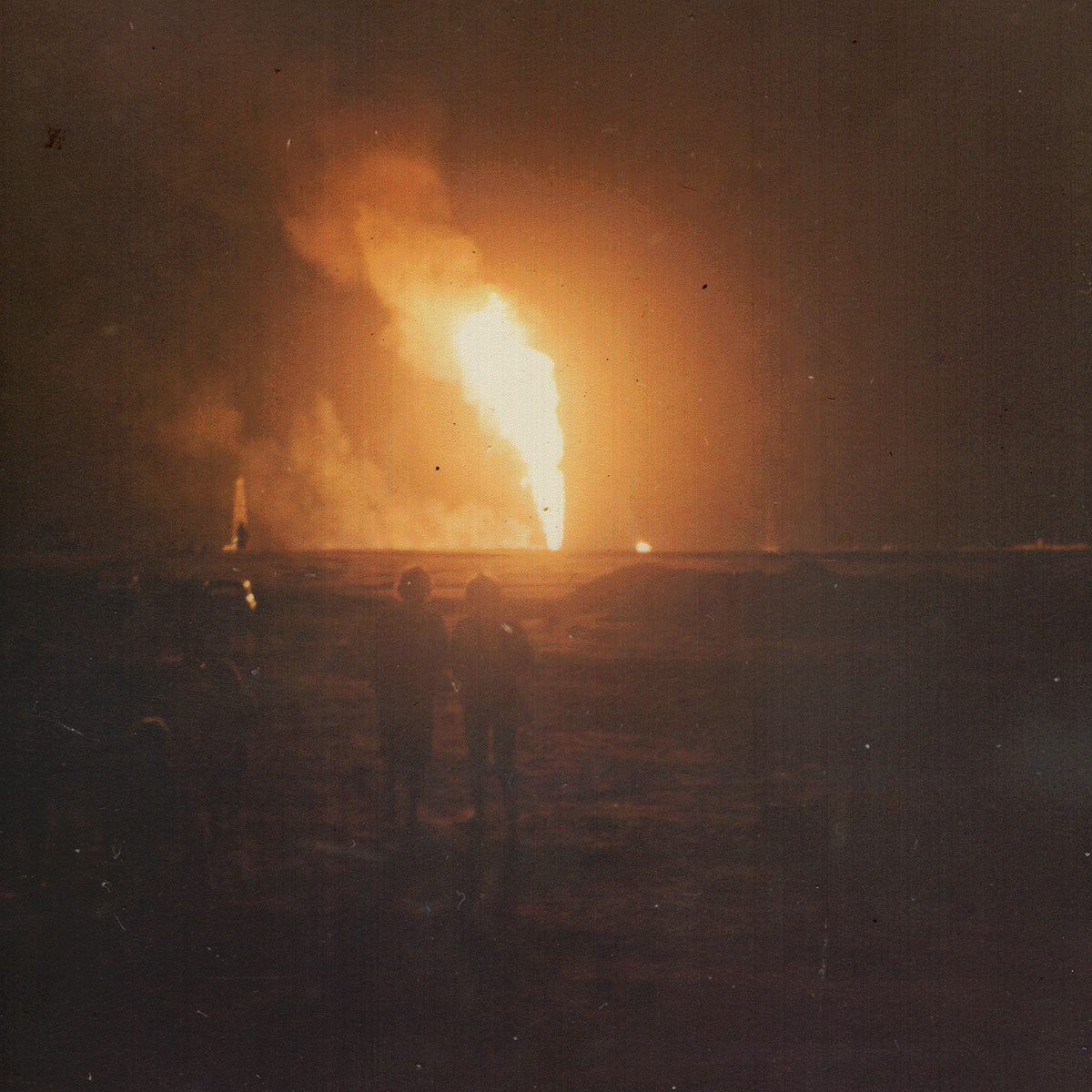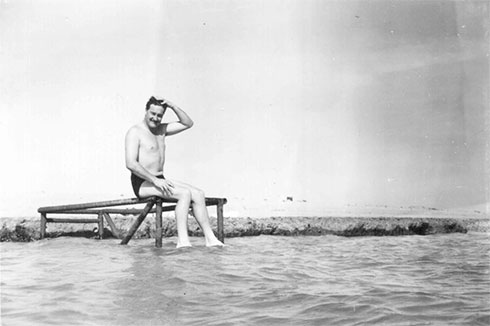
Below is another interesting story by John Beresford who used to live in Kuwait back in the 50s and 60s. This time it’s about The Burgan Blowout which I hadn’t heard about until I read his story. It’s a bit long but if you like old stuff related to Kuwait you’ll find it interesting.
I am sure that there are quite a few people reading this who were in Kuwait after the Iraqis were driven out during the first Gulf War and who experienced the nightmare of the destruction of the oilfields when the Iraqis blew up so many oil wells. I don’t know what that was like, the pollution, the burning, I don’t know if the ground trembled and if people heard a constant moan which, on getting closer, became a roar. But I did experience Burgan Well 331 and as far as I can remember, these are my memories.

The Kuwaiti was the weekly magazine for KOC employees, printed in English and Arabic. The photo on the cover states that the relief well was drilled from a point 1526 feet away from the blowout – approx. 500m. Drilling from there they had to hit a pipe that was 9” wide and hopes that they could pump drilling mud down it to block the well. From the angle of the picture, I think you just do not get any idea of how big or powerful the flame was, but then I was only about 10 ½ years old and I had never experienced anything like this so I might be exaggerating.
To try and put the flames out they needed water, so a pipeline was built, working 24/7, to bring seawater to the well site. I don’t remember if it was 48” pipe or 36”, laid across the desert with every available person and piece of equipment on the job, and it was built in about 1 week. I am sure my father said that it was a week, or just over. Everything was thrown at getting this done. It was a lot of pipes but the steel could be transported flat on trucks and ‘spun’ (spirally welded) as it was laid, which made everything easier. The bulldozers went ahead and flattened the desert and scraped a track alongside which was graded and then the machines came along to build the pipeline.
I remember that at night the horizon was bright with the light of the flame. We lived in Ahmadi at 44/14th Avenue – I don’t know how far away Burgan was, but of course, us kids had to see if we could read by the light of the flame – we could, although at that age our eyes were a lot better than they are now and maybe we could have read by moonlight anyway. And we thought we could hear something, a type of low moan.

The well fire was big, but once the process started to put it out, it became the biggest tourist attraction in the whole of Kuwait and so a plan was put into place to let the public come and see it, but in a controlled manner, so that it was safe and so that no one got in the way. So one evening we got into the car (a little Ford Anglia, same as the car Harry Potter goes flying about in) and drove off to Burgan, and we found ourselves in a bit of a convoy. With my brother and sister I was excited, my mother less so. The red horizon stirred in her memories of 14-15 November 1940, when Coventry had been bombed and the old heart of the city completely destroyed by fire. She was a student nurse in Nottingham and was fire watching that night – she was on the roof of the hospital, with buckets of sand and water and a little pump, to look out for incendiary bombs that might land there and to try and put their flames out before they really got going. If it looked bad she had to raise the alarm. It sounds dangerous but she always maintained that the most dangerous part of it was not falling off the roof! Anyway, she had had a grandstand view of the horizon towards Coventry and saw it light up and just keep on burning, and she said that the well fire reminded her of that night. The destruction was so complete that the Germans coined a new word ‘coventrieren’ meaning to completely destroy a city.
As we drove on the moan became louder and dad asked if we could feel anything; the car felt odd. In fact, the force of the gas coming up, uncontrolled, through the well piping was causing the ground to vibrate and we were starting to feel this through about 5 miles away from the burning blowout. I thought we parked 5 miles away and walked to about 3 miles distance away but now I don’t think that was so, from the silhouette of the oil rig you can tell it is not 5 miles away. I am not sure if it is the relief rig that was about 500m away from the fire as there were quite a few rigs in the area anyway. We got out of the car and it was warm. Kuwait is always going to be warm by most people’s standards, but take away the climate and how we had felt when we went out to get into the car, and now it was warm. And we could feel the vibration through our shoes, into our legs, not big movements, not lurching ones as in an earthquake, but a constant vibration which, while it did not unbalance anyone, did feel odd.
We were grouped and taken to a viewing location, which was nearer. As we got closer the vibrating grew, the sound got louder and we had to speak more loudly, almost shouting, and the temperature increased to a level that was unpleasant. Our skin facing the flames got quite warm. The power coming out of the earth was extremely impressive and it was only one well, one 9” diameter hole, blown out. How many were burning after the 1st Gulf War? All the destruction must have been a scene from hell.

We then got rounded up, counted, and led back to our cars, we got into them, drove back home and our adventure was over. We did manage to take a few photographs and I attach 2 of them. The camera was an old, fold-out, bellows camera with no telescopic lens. I think these 2 pics were taken from the car park as in the originals I can just make out some vehicles. I have another picture that is comprised of 2 photos, a top and a bottom that actually do fit together – if I could find them I would post them – but they produce an image which is about twice the size of these, so I guess they were taken from the viewing area. Basically the same image, but bigger.
At this time I was back in Kuwait with my parents because it was the Christmas holidays. At the age of 9 years old I had been sent back to the UK to go to boarding school. The logic was that as dad was going to be working overseas, and because the KOC school – the Anglo American School – only took children up to the age of 13, I would have to go to boarding school when young in order to get taught for the Common Entrance exam which I needed to pass at the age of 13 to get to Public School (the English term for a private school that took children as borders until they were 18 and had done their exams to get to university. There were just about no State-run boarding schools back then). And at the time there might have been 1 school in Kuwait Town that took children up to 18 or so but it wasn’t clear if their exams would count towards a UK university entrance so boarding school at 9 it had to be. This meant that after the holidays I had to fly back to London in order to go back to school.

So, whatever day it was that I flew back, my parents took me to the airport, which was on the site of the Kuwait International Airport is now (I think) but it was the original one in that location before any updated version was built. Parents were allowed to sit with their children in the departure lounge until the flight was called. And as we were sitting there my father said ‘John, look over there’ and sitting with some companions was Red Adair himself, the guy who had been called in to put out the well fire. He was wearing a long-sleeved cotton shirt, collar unbuttoned, his trousers were over his cowboy boots and dad said ‘Look at him, see, he’s missing part of a finger’. And I looked, and yes, there was the end of a digit missing. In fact, there seemed to be several bits missing, there were assorted small scars, burn scars, I think there was a bit of an ear missing, he moved a bit differently to most people because he kept running into flames and heat and played with explosives but he must have had a good idea what he was doing because he was still alive. Several children went up to him and asked for his autograph, which he graciously gave to them, and he chatted to them even though he had such a tough reputation as someone who could not be killed. He allegedly earned a fantastic amount of money and his contract said that any oil company that called him in had to supply the equipment he wanted and after the job, he got to keep it and the oil company would store it for him until he needed it again. But basically, for KOC, it was a form of insurance. He and his team put their lives on the line to put out fires. Thank God they did!
Interesting Fact: Red Adair was brought back to Kuwait 26 years later in 1991 after the Iraqi invasion to cap the burning oil wells.
In 1991 Adair was asked to help cap the oil fires set by Iraqi troops fleeing Kuwait during the Persian Gulf War. Although it was thought that controlling these fires would take years to accomplish, Adair’s team capped 117 wells and aided other teams in completing the job in eight months. Adair retired from firefighting in 1994. Source
Note: Scans of The Kuwaiti magazine taken by SJM Banfield (if anyone knows him let me know!)
Update: Here is a photo of the Blowout taken from the Tarek Rajab Museum archives.
































